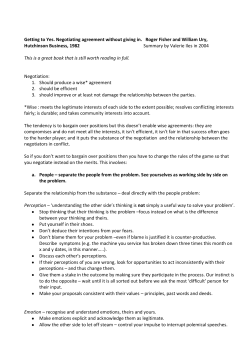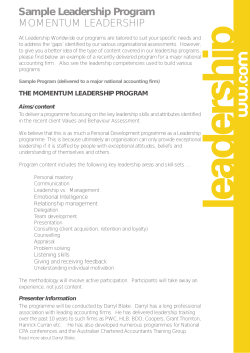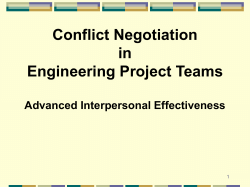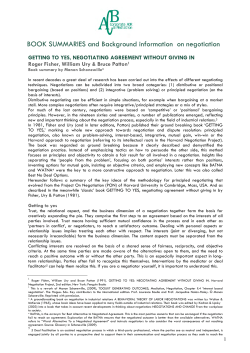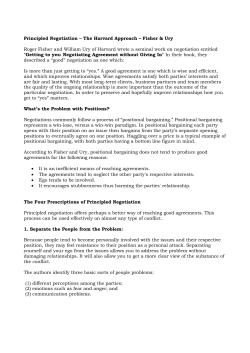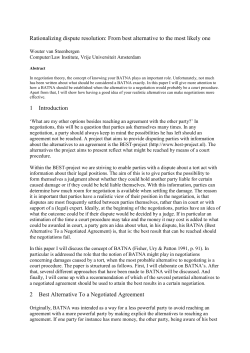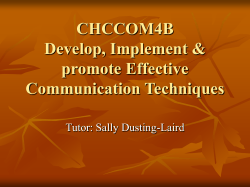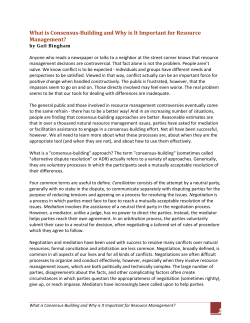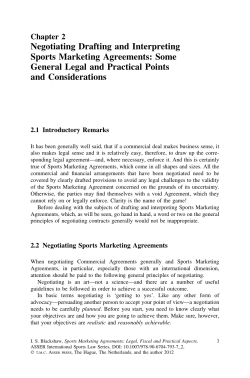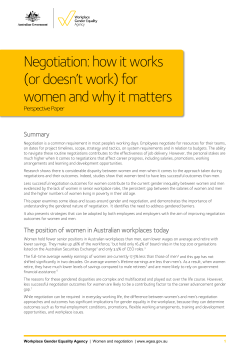
Negotiation Genius How to Overcome Obstacles and Achieve Brilliant Results
Ss Negotiation Genius How to Overcome Obstacles and Achieve Brilliant Results at the Bargaining Table and Beyond by Deepak Malhotra and Max H Bazerman What does it take to become a genius? Unless you are born with it, is it even possible? The good news, say Harvard Business School Professors Deepak Malhotra and Max Bazerman, is that, while you might not be able to emulate the genius of Mozart or Einstein in their respective fields of achievement where they undoubtedly were born with innate greatness, it is perfectly possible to start from scratch and learn to become a genius when it comes to negotiations. They should know. Drawing on the latest research in negotiation and dispute resolution, the experience of thousands of their clients and students, and their own activity as negotiators, they have compiled a toolkit of tried and tested negotiating techniques and an insight into the real-world process of bargaining. The fundamental keys to success are sound preparation and the acquisition of information — knowing as much as possible not only about the other party and their perspectives — but also about your own objectives and prejudices and the roots of irrational behavior that can derail negotiations. With these keys, you can apply influencing strategies to secure a good deal and unlock additional value for both sides. You can also turn apparently hopeless situations into remarkable successes, as did Theodore Roosevelt's manager during the Presidential campaign of 1912. Three million flyers had been printed using an arty picture of Roosevelt for which, unwittingly, permission had not been sought from the photographer. Copyright laws would allow the photographer to claim $1 for each usage — $3m in total, which is more than $60m at today's values. Instead of panicking and trashing the whole lot — which many thought was the only available option — the wily manager approached the photographer, offering him the unique opportunity of gaining nationwide publicity for his photographic prowess — for a fee! The photographer came up with his best offer — he would pay the campaign $250 for the privilege of having his photo used! The rest, as they say, is history. "When the task is difficult, when obstacles arise, when negotiations are unraveling and when it looks as if the deal is lost, most negotiators will panic or pray," say the authors. "Negotiation geniuses, in contrast, will only strengthen their resolve to formulate and execute sound negotiation strategy." Claiming Value The first and most basic element of negotiation that people seek is to get the best 1 | The Business Source www.thebusinesssource.com All Rights Reserved Ss possible deal. This means securing the biggest slice of the pie or claiming the most value from what is available. That is most likely achieved through the work you do before discussions even begin, the stage when most mistakes are actually made — not through faulty preparation but through no preparation at all. The authors propose a five-step pre-negotiation strategy, which also introduces important tools for the whole negotiation process: Step 1 – Consider what you will do if you cannot reach a satisfactory agreement. This is your Best Alternative To Negotiated Agreement, or BATNA. Step 2 – Calculate your walk-away point, the Reservation Value or RV, below or above which (depending on which side of the table you are) you will not go. Step 3 – Assess the other party's BATNA. In the Roosevelt example, the photographer's BATNA was quite poor: if he didn't reach a deal, the valuable of the publicity opportunity would be lost. Step 4 – Try to establish the other party's RV. This may not be easy but research and asking questions will take you beyond merely guessing. Step 5 – The difference between the two RVs is the Zone Of Possible Agreement, the ZOPA, and your task is to secure as much of this zone as you can. Once negotiations begin, the first critical point is when one side makes the first offer. This is the "anchor" which focuses the other negotiators' attention and expectations. It is a powerful device. For example, in research, four real estate agents were asked to value the same property after each was given an MLS listing with a different asking price. Their valuations tracked the asking price — the higher it was, the higher the agent's valuation. However, the authors caution against setting the anchor yourself unless you have sufficient information about the other side's RV. If, instead, the other party sets an anchor that you do not like, you can respond to this by ignoring it, avoiding discussion of it or making an aggressive counter-offer outside of the ZOPA, which will keep the whole range of the ZOPA in play. Creating Value Claiming value is just a bargaining starting point. Negotiation geniuses go well beyond this by seeking to introduce new elements that will add value to the overall deal, effectively making the pie bigger. Not only that, but they will also try to do so in a way that doesn't hurt the other party. They look for opportunities to create additional value by introducing multiple tradable issues into the discussion. This allows you to concede elements that are unimportant to you but matter to the other side, for reciprocal concessions that 2 | The Business Source www.thebusinesssource.com All Rights Reserved Ss they may not be too concerned about but which are important to you. Trading multiple issues is known as "logrolling" and is especially useful when a deal is otherwise focused on one divisive issue. Smart negotiators recognize the limitations of one-issue deals and try to broaden the scope. For example, instead of just discussing price, a negotiator might introduce other deal-making factors such as delivery, financing, quality, contract length, arbitration and exclusivity clauses, warranties and future business. The goal, the authors suggest, is to constantly seek improvements in the deal until you reach the point where it is impossible to make one party better off without hurting the other. How do you know when you're there? Tough question, they say, but if you end the negotiation without knowing very much about the other side's interests and priorities then you have almost certainly left value on the table. Four simple actions, again before talks start, will prepare you for creating value in a way that will deliver benefits to all concerned: 1. Identify your multiple interests. Do not sit down thinking that you should only be talking only about a single issue. 2. Create a scoring system that allows you to order your priorities so that you know what is tradable so you can properly evaluate concessions and offers from across the table. 3. Calculate an RV for the overall package, not for individual items; this may prompt you to reconsider your own flexibility on certain issues. 4. Identify the other party's multiple interests so you can trade in a way that is profitable for both sides. Multiple issues should ideally be negotiated simultaneously. Otherwise you cannot "logroll." That doesn't mean that you should literally talk about all the issues at once; rather, you should avoid final agreement on any specific issue until all have been discussed. At this point, you can make a "package offer" that ties up all of them. Investigative Negotiation Negotiation is about information. Those who know how to get information generally do better than those who don't. Establishing all the facts can be a way through impasse and open the route to cooperation, the creation of new value and mutual satisfaction. Illustrating this point, the authors relate the story of stalled negotiations between an American healthcare product manufacturer and a European raw material supplier that was resolved with a single, one-word question. The US firm wanted an exclusive-supply deal which the European company consistently refused. Several times, the American offer was improved — more cash, bigger orders, future guarantees — because the company did not want to 3 | The Business Source www.thebusinesssource.com All Rights Reserved Ss begin making its new product under the threat of competition. Always the same shaking of heads on the other side of the table. A negotiation genius, flown in by the US outfit, asked the Europeans a simple question: Why? The answer: We need to supply a small quantity to the business owner's cousin for a product he sells locally. Within a short while, a deal was reached that gave the Americans their exclusivity with the simple exception of the side deal with the owner's cousin. Problem solved. The story underscores the need for negotiators to approach their work in the same way a detective might consider a crime scene, the goal being to learn as much as possible about the situation and the people involved and act accordingly. But eliciting information is not always as simple as asking "Why?" especially if the other party is particularly reticent. Possible ways around this are by: Building trust and sharing information. This is best done over time, beginning outside of the negotiating arena and keeping in touch between contracts. Asking indirect questions. Don't assume they won't be answered and, perhaps, frame questions that might collectively help build a picture of their position and priorities, such as how a deal will fit with their strategy. Giving away some information. This could be confidential but not critical information that will establish your integrity as a negotiator and could stimulate the human tendency to reciprocate. Negotiating multiple issues simultaneously. This is a good way of clarifying the other side's interests and priorities by identifying which ones they hone in on and where there is likely to be room for compromise. Making multiple offers simultaneously. If you make similar offers, equal in value but with different components, you will be able to establish where their key interests lie. The Psychology Of Negotiation Building on the essential elements of preparing for negotiations and acquiring key information, the book explores how the prejudices and biases of all negotiators, including you, can influence attitudes and performances at the negotiating table, prompting us to behave irrationally and make costly errors. Examples include the 2004 National Hockey League lockout, which ended when players accepted a deal that was worth considerably less than one they had originally rejected, and a dispute over who should pay a $900 bill for apartment window bars which the apartment owners and condo association fought in court, running up $100,000 of legal bills in the process! Quoting economist Thomas Schelling, the authors suggest the trouble is that each individual behaves like two people, facing internal struggles between doing what 4 | The Business Source www.thebusinesssource.com All Rights Reserved Ss they want to do and what they think they should do. Too often, the want-self dominates the should-self, leading people to make decisions on instinct and gutfeeling rather than weighing the issues carefully and rationally. The solution is to deal with this conflict before the negotiations actually begin so that you know what the "should" approach will be, as well as being able to predict and therefore deal with or restrain the impulsive "want" issues that might arise during discussions. For instance, you may know that the other side's tactics have the potential to anger you, tempting you to behave shortsightedly — the "want" way. By thinking in advance — when you are not angry — about the correct, "should" way to respond, you will be much better equipped and disciplined to deal with this situation. Other psychological issues in negotiations that we encounter and must deal with include: Egocentrism – the tendency for perceptions and expectations to be biased in our favor. Negotiation geniuses tackle this by imagining what they would believe to be fair if they did not know their own role in the proceedings. Overconfidence – unrealistic optimism can prompt you to reject what turns out to be the best offer (as in the NHL lockout) or to rely on just a single strategy, without fallback, at the negotiating table. Self-serving attributions – the tendency to see our role in past events in a positive way. This keeps us feeling good about ourselves but blinds us to the need to learn lessons and improve performance. Regret aversion – trying to avoid situations that might cause us painful thoughts about "what might have been." This can cause negotiators to hold out longer and for more than they should. To counter these and other personal biases we are again encouraged to try to look at ourselves objectively from the outside, to curb reliance on our intuition, and to confront and learn the lessons of the past. Negotiating In The Real World So far, the authors have equipped us with tools for claiming and creating value, acquiring information and anticipating the psychological issues we face at the negotiation table. Now we learn about the influencing strategies that will put those tools to work — techniques that can be used to sell your ideas, persuade reluctant opponents and convince others of the merits of your case. Malhotra and Bazerman propose eight main strategies of influence: Highlight potential losses rather than potential gains: Research shows that people are more likely to react in your favor when the implications of not doing something, rather than the benefits of complying, are presented. When Santa 5 | The Business Source www.thebusinesssource.com All Rights Reserved Ss Cruz residents were told how much they would "lose" by not insulating their homes, far more opted for insulation than among those who, conversely, were told how much they would save. Although the sum was identical in each case, presenting it as a negative or a loss was a far more powerful call to action than depicting it as a savings or gain. So, frame your proposal in terms of what the other side stands to lose if rejected rather than the benefits they will gain if accepted. Disaggregate their gains and aggregate their losses: A survey showed that people would rather find two $10 bills on successive days than a single $20 bill, but would prefer to lose a $20 note in one go rather than $10 on each of two days. So, if you can make concessions don't do it all at once — keep them smiling. But if you have bad news or more burdens to impose, it is more effective to deliver them in a single message. Employ the door in the face (DITF) technique: Compliance is more likely to increase after an initial rejection of an aggressive offer. In a street poll, only 17% of people said they would be prepared to take a party of juvenile delinquents to the zoo. But when people were first asked if they would become part time counselors at a juvenile center for three years — which they universally rejected — some 50% agreed they would take the teens to the zoo. So, if you want something, ask for more than you want and be prepared to make concessions. Employ the foot in the door (FITD) technique: A bartender asked half his patrons to sign a petition against drunk driving. When they subsequently became inebriated, he offered to call them a taxi and 58% agreed, versus 10% of those who had not been asked to sign the petition. The message? Willingness to agree to one request tends to induce commitment to additional requests that flow from it. Leverage the power of justification: Don't let your offer speak for itself; explain the reasoning behind it. Research shows the psychological power of "because." When a researcher tried to cut into a line of people waiting to use a copy machine, 60% agreed, but when the researcher added the phrase "because I have to make some copies" acceptance shot up to 93%, even though it was a perfectly obvious explanation. Leverage the power of social proof: Every parent knows how teenagers use claims like "everyone else is going" to gain consent. In an experiment, an infomercial, instead of urging people to "call now," added: "If operators are busy please call again." The notion that everyone was buying — social proof — caused orders to rocket. In business, consider listing your many clients or demonstrating how busy your diary is as social proof of your success. Make token unilateral concessions: Offered a $20 reward for completing a survey, only a small percentage responded but when a dollar bill was preemptively mailed out with every survey request, the response was significantly higher. Lesson: a low-cost concession can induce reciprocity. So, consider agreeing to meet at a time or location that is more convenient for the other party, bringing food and refreshments to the meeting or beginning discussions by agreeing to one of the 6 | The Business Source www.thebusinesssource.com All Rights Reserved Ss other party's smaller requests. Use reference points to make your offers and demands seem reasonable: A deal may be more or less attractive according to how it is presented, what it is compared with and how much of a "bargain" it is shown to be. For example, people were prepared to pay more for beer bought in an expensive-looking store than one in a rundown grocery outlet, even though it would be consumed in the same place. What about telling lies or using anger as influencing strategies? Absolutely not, say the authors, deceit or coercion is never a good idea over the long run but that does not mean that you won't encounter these strategies from across the table. So how do you deal with deception? Your base strategy should be to try to preempt it by looking prepared, signaling you have done your homework and speaking in a way that suggests you know a lot about the industry outside of the negotiating room. You can also signal your ability to obtain information and frame your questions indirectly so they are not seen as aggressive or threatening. If you do suspect deception, learn more. Try gathering relevant facts from outside sources that will enable you to challenge the other's assertions, for example about price, delivery or market conditions. You might even set a trap — asking a sensitive or critical question on something like current market prices, to which you already know the answer. Sometimes, a series of questions that appear merely to seek information can lead cumulatively to a challenge. The authors call this "triangulating on the truth." Let's say that the other party claims they have received a better offer elsewhere. The authors suggest the following set of questions: When did you receive the offer? What was the offer? Were you given specific product information? What was that information? Was the offer made in writing? If not, why not? If yes, may I see it? As for anger, although the authors' strategy of pre-planning should eliminate the temptation for you to resort to it, they do offer guidance on how to respond when it erupts on the other side of the table, pointing out that even if you think the outburst is totally unjustified, the angry party might think just the opposite. You should seek to understand why they are angry and invite them to give voice to their feelings by saying something like: "I can see you are angry and I want to understand why that is. Tell me why you feel that way." Whatever happens, you should not take it personally. Instead, try to help the 7 | The Business Source www.thebusinesssource.com All Rights Reserved Ss angry person shift attention from whatever has fuelled the outburst and refocus on the substantive issues, by asking them what they would like to see happening now and what would help put the issue behind all of you. Negotiating Weakness Of course, there will be times when, despite all your learning and application of techniques, you may find yourself negotiating from a position of weakness, but, as Roosevelt's manager demonstrated, it is still possible to pull off a brilliant result, especially if you do not reveal your weakness and focus instead on the other's vulnerabilities. You can still identify and try to leverage what strengths you do have in your proposition by bringing something to the table that distinguishes you from the competition. Even so, there may be occasions when it makes sense not to negotiate. For instance: When the costs of negotiation in terms of time and money exceed the amount you stand to gain. When your BATNA stinks and everyone knows it. For example, you may be negotiating employment terms when you have no other job offers. When relationships might suffer. By driving too hard a bargain with a builder, a house-building couple could find him uncooperative when they need his help in the future. Becoming a Genius The secret of becoming a negotiation genius boils down to the distinction between experience and expertise. Experience comes from doing the same thing — such as negotiating — over and over. Expertise comes when you apply strategies and what you have learned from that experience. With negotiating, that means acquiring as much information as you can, preparing yourself in advance, analyzing your performance, dealing with prejudices and learning from others. Applying these principles to your experience will lead you down the path to genius. 8 | The Business Source www.thebusinesssource.com All Rights Reserved
© Copyright 2025

